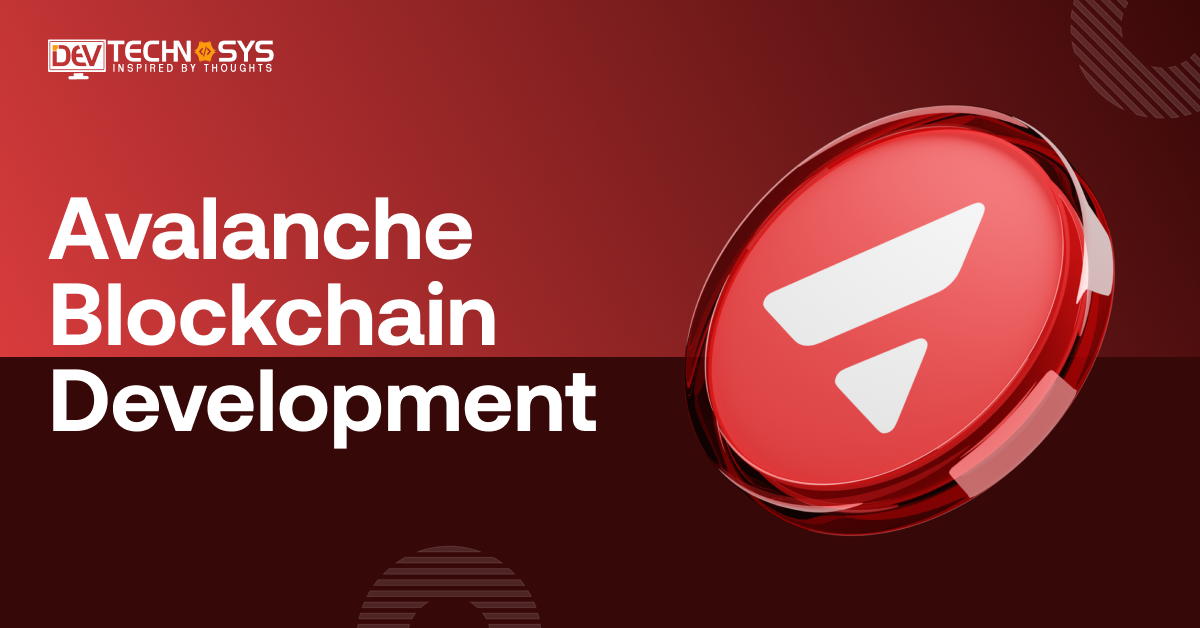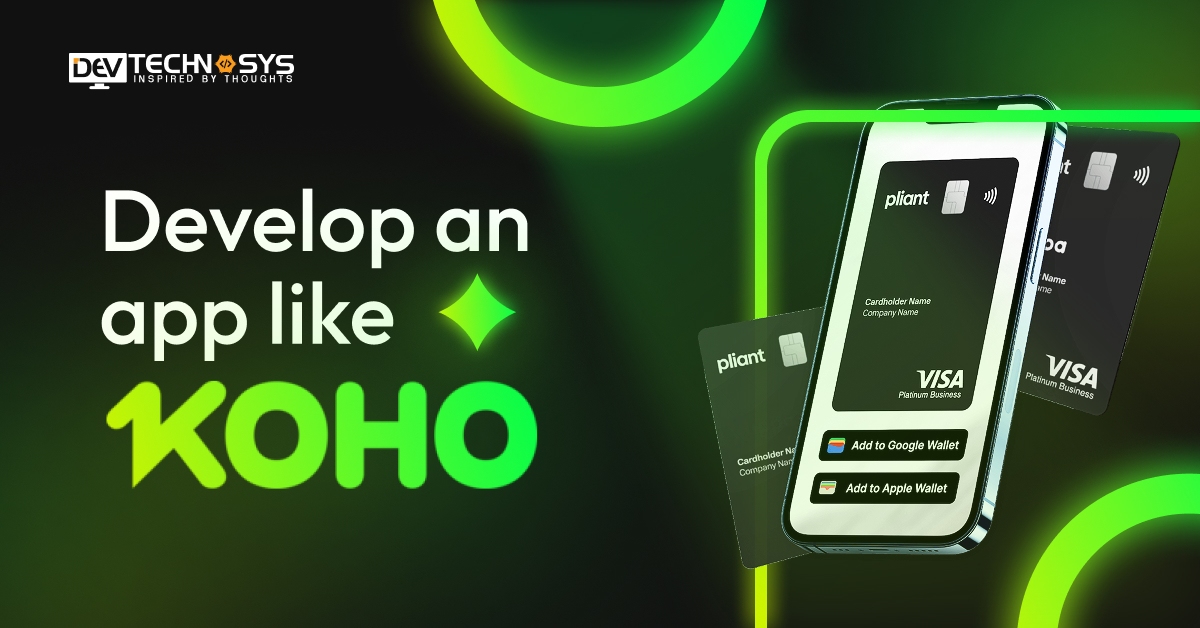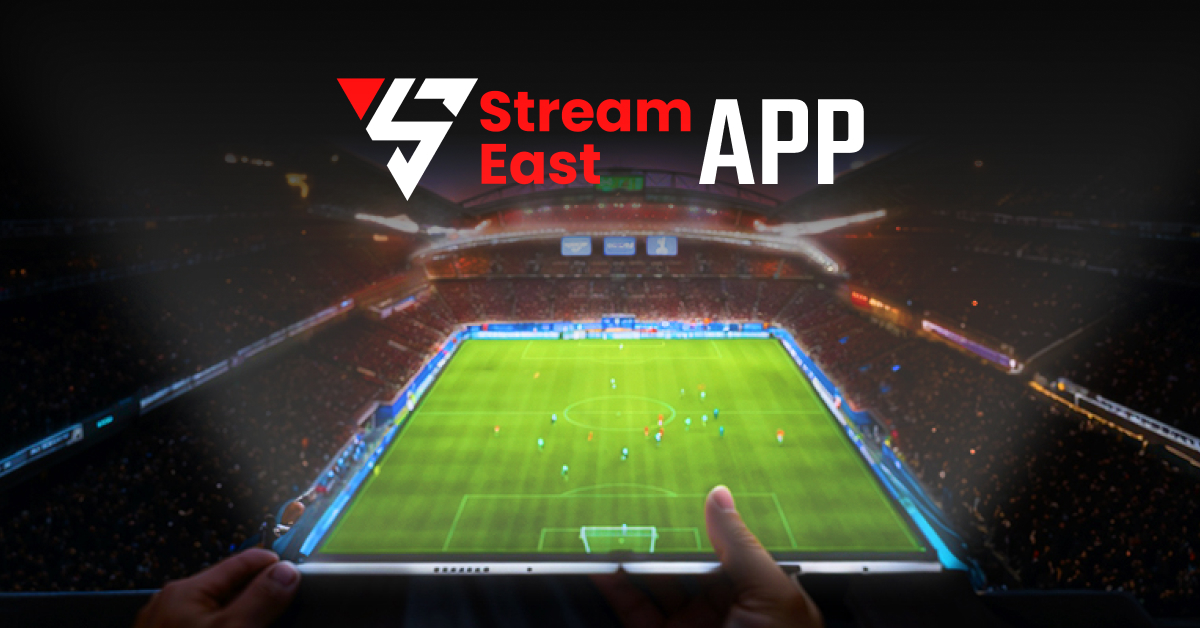“Next-Gen Blockchain Power”
Let’s talk about the blockchain networks; there are many popular networks, such as Ethereum, Solana, and Hyperledger. But there is one blockchain network that has a faster transaction speed than the other; it is the Avalanche blockchain.
It was created by Ava Labs in 2020 to develop decentralized applications, smart contracts, and other digital tools. Avalanche blockchain is the biggest and most powerful competitor of Ethereum and Bitcoin.
In the last few weeks of research, Avalanche (AVAX) has exhibited tremendous gains over the last week, jumping 20.61% to hit the $22.89 mark.
This data reveals how rapidly the Avalanche blockchain grows and helps developers to create powerful dApps and smart contracts.
In this blog, we will provide detailed information about Avalanche blockchain development and other related sections.
Hang on!
What is Avalanche Blockchain?
Avalanche is a high-performance, open-source blockchain platform designed for decentralized applications, custom blockchains, and digital assets. Known for its speed, scalability, and low fees, it uses a unique consensus protocol to achieve near-instant finality.
With support for Ethereum-compatible smart contracts and customizable subnets, Avalanche enables developers to build fast, flexible, and secure blockchain solutions across various industries.
- Subnet Functionality
- Scalable Architecture
- EVM Compatibility
- Low Transaction Fees
7 Popular Blockchain Platforms Like Avalanche
Explore 7 Popular Blockchain Platforms Similar to Avalanche Offering High Speed, Low Fees, Smart Contract Support, and Scalable Infrastructure for Building Next-Gen Decentralized Applications Across DeFi, NFTs, and Enterprise Blockchain Use Cases.
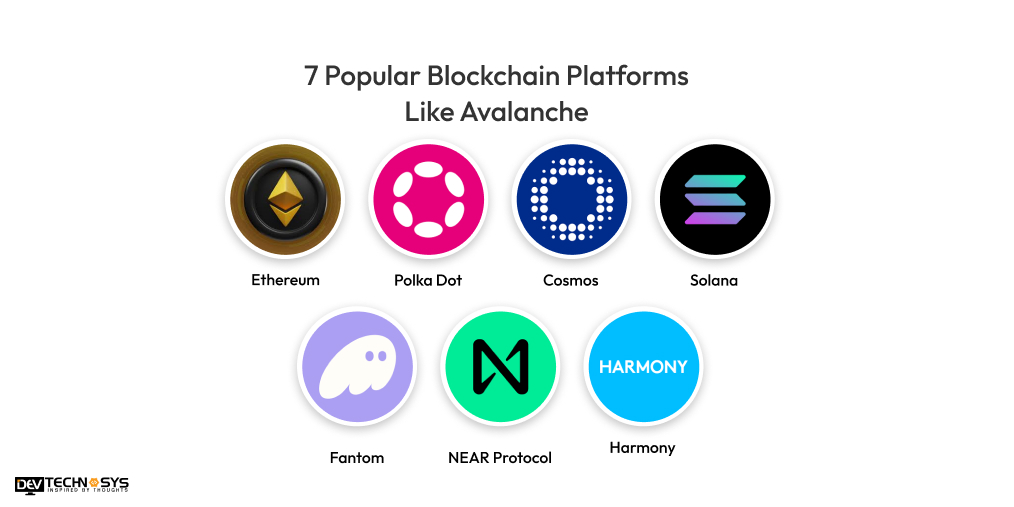
1. Ethereum
Ethereum is the most established smart contract platform, with thousands of decentralized apps. Despite being slower and more expensive than Avalanche, it provides superior programming tools, community support, and security. Ethereum development company updates aim to increase scalability and dramatically cut gas fees in the foreseeable future.
2. Polka Dot
Polkadot’s relay chain and parachain design support interoperability between several blockchains. Developers can design bespoke chains that are tailored to specific needs, similar to how Avalanche subnets work. It is appropriate for scalable, interoperable applications and prioritizes safe communication across separate blockchain networks in its ecosystem.
3. Cosmos
Cosmos aims to create an “Internet of Blockchains” by empowering developers to create sovereign, scalable blockchains that can communicate using the IBC (Inter-Blockchain Communication) protocol. Its modular SDK, which is comparable to Avalanche subnets, allows for the creation of application-specific chains that are flexible and customizable.
4. Solana
Solana is recognized for its high throughput and incredibly low fees, which stem from its unique Proof of History (PoH) consensus paired with Proof of Stake. With the help of Solana blockchain development company to build high-frequency trading, DeFi, and gaming dApps, albeit it’s seen intermittent network disruptions during peak demand.
5. Fantom
Fantom is a fast, scalable blockchain technology designed specifically for DeFi and smart contracts. Fantom uses a DAG-based consensus protocol named Lachesis to provide quick transactions at low cost. It is entirely EVM-compatible, so developers may simply transfer Ethereum-based applications to its network with few changes.
6. NEAR Protocol
NEAR Protocol is a developer-friendly blockchain with high throughput, cheap fees, and a distinct account type. It enables scalability through sharding and is designed to encourage widespread adoption of decentralized apps. Its simplicity and usability appeal to both seasoned developers and blockchain beginners.
7. Harmony
Harmony uses Effective Proof of Stake (EPoS) and sharding to enable fast, low-cost transactions. It enables Ethereum tools and apps via EVM compatibility and prioritizes cross-chain interoperability. Harmony is suitable for creating scalable Web3 apps that strike a compromise between performance and decentralization.
Why Decentralized Applications Are Built on the Avalanche Blockchain Network?
Discover the Top 5 Reasons Developers Choose the Avalanche Blockchain Network for Decentralized Applications—From Fast Transactions and Low Fees to EVM Compatibility, Customizable Subnets, and Eco-Friendly Scalability, Avalanche Provides the Perfect Environment for Creating Fast, Flexible, and Future-Ready Avalanche blockchain development solutions.
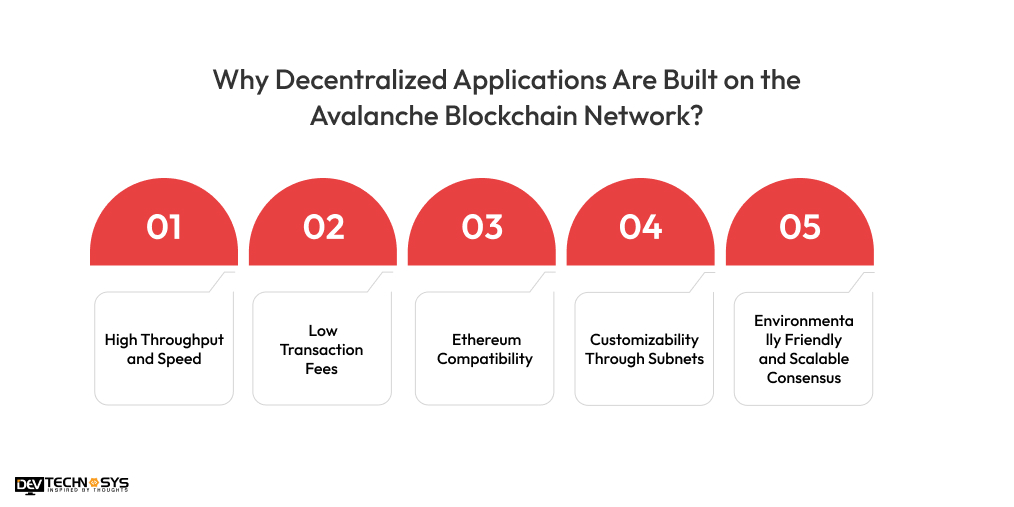
1. High Throughput and Speed
Avalanche is intended for speed. It can handle more than 4,500 transactions per second (TPS) and complete transactions in under two seconds. This lightning-fast performance is crucial for decentralized apps (dApps) that rely on real-time user interactions, such as gaming platforms, DeFi protocols, and NFT marketplaces, where delays can degrade user experience and confidence.
2. Low Transaction Fees
High gas fees have been a significant barrier for dApp developers on networks such as Ethereum. Avalanche provides a far more cost-effective alternative, with significantly cheaper prices.
According to the dApps development company, it enables dApps to scale without imposing a financial cost on users, making the network appealing for initiatives seeking widespread adoption.
3. Ethereum Compatibility
The Avalanche C-Chain is completely compatible with the Ethereum Virtual Machine (EVM), allowing developers to implement Ethereum smart contracts without modification.
Existing Ethereum-based dApps can easily transition to Avalanche or function in a multi-chain environment, taking advantage of both Avalanche’s speed and Ethereum’s ecosystem.
4. Customizability Through Subnets
Avalanche allows developers to create custom blockchains—called subnets—tailored to specific business or application needs. These subnets offer full control over the rules, validator sets, and tokenomics, making Avalanche highly flexible for enterprise and industry-specific use cases.
5. Environmentally Friendly and Scalable Consensus
Avalanche employs an innovative, energy-efficient consensus protocol that is both secure and scalable. Unlike classic proof-of-work systems, Avalanche’s consensus uses less processing resources, reducing environmental impact while also allowing thousands of validators to participate, further decentralizing the network and increasing trust.
How to Create Digital Applications and Tools Through Avalanche Blockchain?
Learn How to Build Powerful Digital Applications and Tools on the Avalanche Blockchain with These 7 Essential Steps—From Defining Your Project and Writing Smart Contracts to Testing, Deployment, and Launching on Avalanche’s Fast, Scalable, and Developer-Friendly Platform.
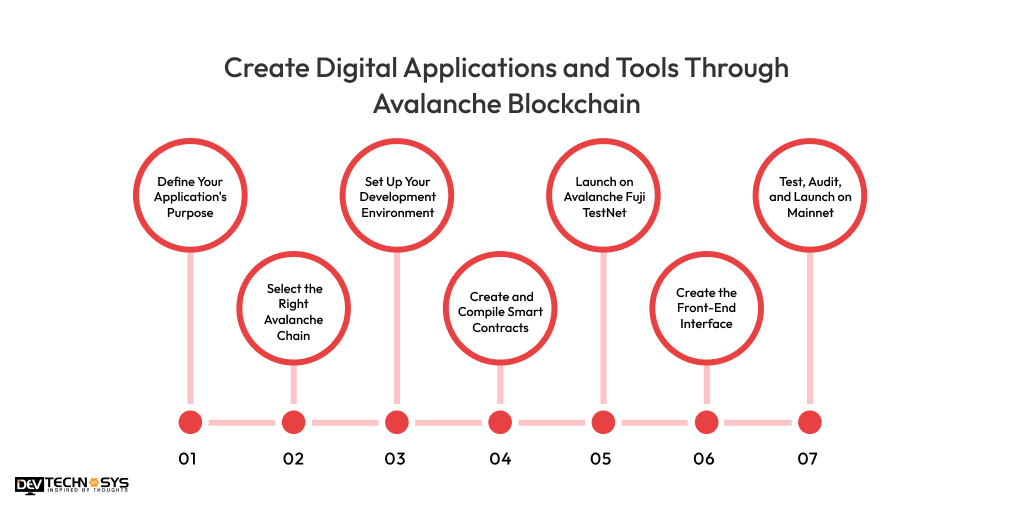
1. Define Your Application’s Purpose
Begin by defining what problem your application solves or what value it offers. Hire Avalanche developers to develop a DeFi platform, NFT marketplace, supply chain tool, or DAO.
This clarity guides your technical architecture, user interface design, and smart contract logic while also ensuring alignment with Avalanche’s scalability and performance.
2. Select the Right Avalanche Chain
Avalanche comprises three core chains: X-Chain for asset transfers, C-Chain for Ethereum-compatible smart contracts, and P-Chain for validator coordination and subnet construction.
Most digital applications, particularly those requiring smart contracts, use the C-Chain. It enables you to use existing Ethereum tools while benefiting from Avalanche’s fast and low transaction fees.
3. Set Up Your Avalanche Development Environment
Hire dapp developers to write and deploy smart contracts, install development tools such as Node.js, Hardhat, or Truffle. Use AvalancheJS to communicate with the blockchain using JavaScript.
Configure your environment to allow access to the C-Chain’s RPC endpoint so that contracts can be easily compiled, tested, and deployed to the Fuji Testnet or Mainnet.
4. Create and Compile Smart Contracts
Use Solidity to create smart contracts that specify your app’s logic, such as token transfers, governance rules, and user interactions. Hire an Avalanche private blockchain development company to compile them with Hardhat or Remix to create bytecode and ABI. This serves as the backend of your decentralized application, implementing rules automatically and securely on the Avalanche blockchain.
5. Launch on Avalanche Fuji TestNet
You can hire blockchain developers to deploy your smart contracts on the Fuji Testnet, Avalanche’s testing environment. This enables you to replicate real-world conditions without using actual AVAX.
Use MetaMask for wallet integration and Hardhat for deployment. Before launching your app on the Avalanche Mainnet, make sure it functions properly.
6. Create the Front-End Interface
Create a frontend using modern frameworks such as React or Vue, then integrate smart contracts with Web3.js or Ethers.js. This interface allows users to interact with your program by signing transactions, minting NFTs, voting, and managing tokens. Focus on user experience and mobile responsiveness to enable widespread accessibility and simplicity of use.
7. Test, Audit, and Launch on Mainnet
To reduce weaknesses, conduct extensive testing and consider hiring a professional smart contract auditor from Tron development company.
Once your app has been determined to be secure, deploy it to the Avalanche Mainnet. Announce your launch via community channels, social media, and developer platforms to attract users and display your app’s capabilities in a real setting.
10 Must-Have Rich Features of Avalanche Blockchain Network
These features make Avalanche a leading choice for building decentralized applications and financial systems. Here are 10 must-have rich features of the Avalanche blockchain network:
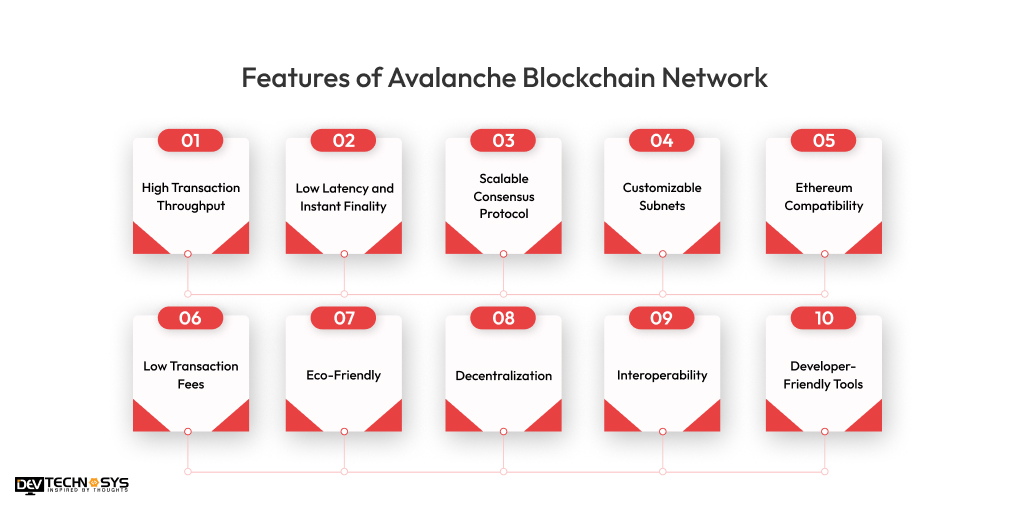
1. High Transaction Throughput
Avalanche has a strong transaction throughput of more than 4,500 transactions per second (TPS), allowing it to easily handle high-demand applications such as DeFi, NFTs, and gaming.
2. Low Latency and Instant Finality
Avalanche provides near-instant finality, with transactions validated in under two seconds. This low latency is critical for time-sensitive applications, since it reduces user wait times.
3. Scalable Consensus Protocol
Avalanche employs a novel Avalanche Consensus Protocol, which is both scalable and energy-efficient.
4. Customizable Subnets
One of Avalanche’s most notable features is the ability to establish bespoke subnets. Subnets let users to establish their own blockchains with custom rules, validators, and tokens.
5. Ethereum Compatibility
Avalanche is EVM-compatible, which means it can run existing Ethereum-based dApps with few modifications.
6. Low Transaction Fees
Unlike Ethereum, Avalanche provides low-cost transactions, making it an appealing option for developers and consumers.
7. Eco-Friendly
Avalanche’s consensus method requires far less energy than typical Proof-of-Work networks, making it a more sustainable and ecologically friendly blockchain solution.
8. Decentralization
Avalanche is extremely decentralized, with over 1,000 validators that ensure network security and trust.
9. Interoperability
Avalanche offers cross-chain communication, which allows assets and data to flow freely between blockchain networks.
10. Developer-Friendly Tools
Avalanche offers a variety of tools and resources for developers, such as AvalancheJS, Hardhat compatibility, and extensive documentation.
What is The Cost of Avalanche Blockchain Development?
The cost to develop Avalanche tokens typically ranges from $8,000 to $25,000, depending on the project’s complexity, features, and scope.
A basic dApp with simple smart contracts and wallet integration may cost around $10,000 to $15,000, while a more complex DeFi platform, NFT marketplace, or enterprise solution with custom subnets and smart contract audits can range from $15,000 to over $20,000.
Costs also include UI/UX design, backend integration, and optional services like audits or DevOps. Additionally, creating a custom subnet requires staking 2,000 AVAX, which is not a fee but a locked network requirement for subnet validation.
Component |
Estimated Cost |
| Basic dApp Development | $8,000 – $13,000 |
| Complex dApp / DeFi / NFT App | $13,000 – $18,000 |
| Enterprise App / Custom Subnet | $20,000 – $25,000+ |
| Smart Contract Audit | $5,000 – $15,000 |
| Subnet Staking Requirement | 2,000 AVAX (staked) |
What Factors Can Affect The Avalanche Blockchain Development Cost?
The cost of Avalanche blockchain development can vary significantly depending on several technical and strategic factors. Below are the key elements that influence the total development cost:

1. Types of Blockchain Solutions
The cost will vary depending on whether you use Avalanche’s default C-Chain (EVM-compatible) or create your own subnet. Subnets need extra design, validator setup, and AVAX staking (a minimum of 2,000 AVAX), which considerably raises the cost to develop blockchain app.
Blockchain Option |
Cost Impact |
| C-Chain (standard dApp) | Lower cost, faster launch |
| Custom Subnet | Higher cost, 2,000 AVAX stake |
2. Project Complexity
The more sophisticated your application, the greater its development cost. A simple token development services or wallet functionality is far less expensive than a complicated DeFi platform, NFT marketplace, or DAO that requires several smart contracts, integrations, and backend logic.
Project Type |
Estimated Cost Range |
| Basic dApp | $8,000 – $13,000 |
| Medium-Complexity App | $14,000 – $20,000 |
| Enterprise-Level Platform | $25,000+ |
3. Smart Contract Development
Smart contract development is fundamental to every blockchain application. If your application employs complicated logic (e.g., yield farming, staking, token bridges), additional effort and expertise will be required. Professional smart contract audits are also strongly suggested for security purposes, which can cost $5,000-$25,000 or more.
Task |
Estimated Cost |
| Simple Smart Contracts | $5,000 – $12,000 |
| Complex Logic Development | $12,000 – $20,000 |
| Security Audit | $6,000 – $13,000 |
4. Frontend and Backend Development
A user-friendly frontend (such as React or Vue) and a strong backend architecture (for processing off-chain data, APIs, or cloud hosting) are required. If your program requires bespoke dashboards, admin panels, or analytics tools, the overall cost of blockchain network development will increase.
Development Area |
Estimated Cost Range |
| Frontend (React/Vue) | $3,000 – $15,000 |
| Backend/APIs | $5,000 – $20,000 |
| Admin Panel/Analytics | $3,000 – $10,000 |
5. Third-Party Integrations
Integration with wallets (e.g., MetaMask), oracles (such as Chainlink), IPFS for file storage, and off-chain data sources can increase complexity and expense. These connections may also result in continuing expenses.
Monthly Maintenance |
Estimated Cost |
| Basic Support | $500 – $2,000/month |
| Full DevOps & Upgrades | $2,000 – $5,000/month |
6. Team’s Location and Size
Hiring developers from many areas might have a significant influence on the price. Teams in the United States or Western Europe often demand more fees than those in Eastern Europe, India, or Southeast Asia. The ultimate cost depends on whether you engage a freelancer, an in-house team, or a custom blockchain development on Avalanche.
Region |
Hourly Rate Estimate |
| North America/Europe | $20 – $35/hr |
| Eastern Europe | $18 – $30/hr |
| Asia (India, SEA) | $15 – $25/hr |
Real-World Use Cases of the Avalanche Blockchain
Discover how Avalanche Blockchain is driving real-world innovation in industries ranging from DeFi and NFTs to gaming, institutional finance, and supply chain, thanks to its high speed, low fees, and custom subnets, making it the preferred choice for scalable, decentralized applications in today’s evolving Web3 ecosystem.
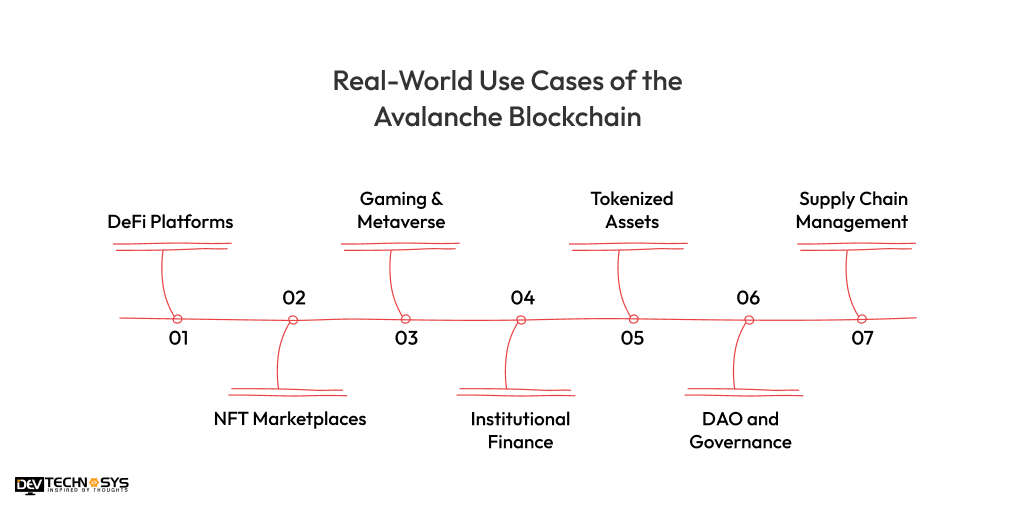
1. DeFi Platforms
Avalanche underpins decentralized finance (DeFi) protocols such as Trader Joe and Pangolin, allowing users to conduct quick, low-cost swaps, yield farming, and liquidity pools.
Its high throughput and EVM compatibility make it perfect for DeFi apps that require Ethereum-level functionality, improved scalability, and significantly cheaper transaction costs.
2. NFT Marketplaces
Avalanche works with NFT platforms like Kalao and NFTrade, allowing artists and collectors to create, acquire, and exchange non-fungible tokens with cheap gas fees. Its eco-friendly consensus approach and easy MetaMask integration make it an appealing option for artists wishing to enter the NFT field cheaply and effectively.
3. Gaming & Metaverse
Avalanche is used to build games like as Crabada and Shrapnel, which benefit from its sub-second finality and scalable infrastructure. According to the Avalanche private blockchain development company, custom subnets allow developers to tune performance and tokenomics for immersive gameplay and metaverse economies, resulting in rich, blockchain-based gaming experiences without the latency or exorbitant fees found on other networks.
4. Institutional Finance
Avalanche is used by businesses and institutions to create safe, scalable financial solutions. Avalanche blockchain development company such as Deloitte, for example, have looked into Avalanche for disaster recovery fund management, noting its transparent ledger and customizable subnets, which allow for compliance while preserving blockchain efficiency—essential for public and commercial use cases.
5. Tokenized Assets
Avalanche allows for the tokenization of real-world assets like as real estate, equities, and commodities. Platforms can use smart contract automation to construct digital representations of these assets that can be traded on-chain at all times.
Blockchain consulting services improves liquidity and transparency while removing intermediaries, resulting in speedier settlements and cheaper operational expenses.
6. DAO and Governance
Avalanche helps communities form decentralized autonomous organizations (DAOs) to administer projects using smart contracts and voting methods.
Protocols such as Colony and Snowball take use of Avalanche’s speed and cost to allow large-scale on-chain governance that is both inclusive and transparent, in line with Web3’s aim of decentralization.
7. Supply Chain Management
Companies utilize Avalanche to add transparency and traceability to their supply networks. By tracking transactions and movements on an immutable ledger, stakeholders can follow items in real time, verify authenticity, and decrease fraud—particularly useful in industries like as medicines, agriculture, and luxury goods.
Conclusion
Avalanche blockchain development services offers a powerful, scalable, and cost-effective solution for building decentralized applications across industries like DeFi, gaming, NFTs, and enterprise systems. Its high throughput, low fees, and customizable subnets make it ideal for businesses seeking performance and flexibility.
Whether you’re a startup or an enterprise, partnering with an experienced blockchain development company can ensure your project leverages Avalanche’s full potential. From smart contracts to custom subnet deployment, expert guidance is key to building secure, user-friendly, and future-ready Avalanche blockchain development solutions.
Frequently Asked Questions
1. What Makes Avalanche Different From Other Blockchains?
Avalanche uses a unique consensus protocol and supports customizable subnets, enabling faster finality (under 2 seconds), high throughput, and lower energy consumption compared to traditional Proof-of-Work networks.
2. What Can You Build on Avalanche?
On Avalanche, you can build decentralized applications (dApps), DeFi platforms, NFT marketplaces, games, DAOs, custom tokens, enterprise solutions, and asset tokenization projects, all leveraging its high scalability, low fees, and customizable subnets.
3. What Are the Benefits of Using Avalanche for Businesses?
Using Avalanche for businesses offers benefits like fast transaction speeds, low operational costs, high scalability, customizable subnets, seamless integration with Ethereum, and robust security, making it ideal for building efficient, decentralized solutions.
4. How Long Does It Take to Build on Avalanche?
Building on Avalanche typically takes 3 to 6 months, depending on the complexity of the project, required features, and the expertise of the development team involved in building decentralized applications or platforms.
5. What Programming Languages Are Used for Avalanche Blockchain development?
Avalanche development primarily uses Solidity for writing smart contracts, along with JavaScript and TypeScript for frontend and backend interactions. Avalanche blockchain developers can also use AvalancheJS for integrating dApps with the Avalanche network.
6. What Are Avalanches Three Blockchains?
Avalanche features three core blockchains: X-Chain (for asset creation and transfers), C-Chain (EVM-compatible smart contracts), and P-Chain (manages validators, staking, and custom subnets within the Avalanche ecosystem).
7. What is Being Built on Avalanche?
On Avalanche, developers are building DeFi protocols, NFT marketplaces, blockchain games, enterprise apps, DAOs, and custom subnets, leveraging its fast transactions, low fees, and scalable architecture for real-world blockchain solutions.
